
Amphipyrinae is a subfamily of owlet moths in the family Noctuidae. There are more than 50 genera and 210 described species in Amphipyrinae, although the classifications are likely to change over time.

Anageshna is a monotypic moth genus of the family Crambidae described by Eugene G. Munroe in 1956. Its only species, Anageshna primordialis, the yellow-spotted webworm, was described by Harrison Gray Dyar Jr. in 1907. It is found in the US states of Alabama, Arkansas, Arizona, Florida, Georgia, Iowa, Illinois, Kansas, Louisiana, Massachusetts, Maryland, Maine, Minnesota, Missouri, Mississippi, North Carolina, New Hampshire, New Jersey, New York, Ohio, Oklahoma, Pennsylvania, South Carolina, Texas, Virginia and West Virginia.

Aglossa cuprina, the grease moth, is a snout moth, family Pyralidae, described by Philipp Christoph Zeller in 1872. The grease moth is closely related to the genus Pyralis, and as a result, is usually associated with the meal moth, Pyralis farinalis.

Sciota subcaesiella, the locust leafroller moth, is a species of moth of the family Pyralidae. It is found in North America, including Maryland, New Jersey, Oklahoma, Iowa, North Carolina, South Carolina, Georgia, Alabama, Mississippi, Maine, New Hampshire, New York, Massachusetts, Pennsylvania, the District of Columbia, Virginia, Tennessee, Illinois, Missouri, Arkansas, Nova Scotia and Ontario.
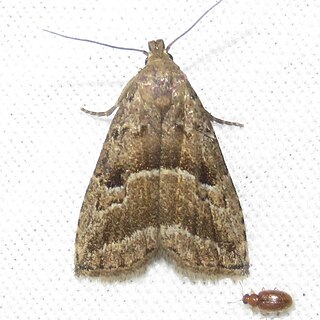
Hypenodes caducus, the large hypenodes moth, is a species of moth in the family Erebidae. It was described by Harrison Gray Dyar Jr. in 1907. It is found in North America, including British Columbia, Maryland, Massachusetts, Michigan, Minnesota, New York, Ohio, Ontario, Quebec, South Carolina and Wisconsin.
Crambidia uniformis, the uniform lichen moth, is a moth of the family Erebidae. It was described by Harrison Gray Dyar Jr. in 1898. It is found from eastern North America, including Alabama, Florida, Georgia, Indiana, Iowa, Kentucky, Maryland, North Carolina, Ohio, Oklahoma, South Carolina, Tennessee and West Virginia.

Cycnia inopinatus, the unexpected cycnia, is a moth of the family Erebidae. It was described by Henry Edwards in 1882. It is found in the United States and Mexico. The habitat consists of high quality barrens remnants.

Cochylichroa hoffmanana, or Hoffman's cochlid moth, is a species of moth of the family Tortricidae. It was described by William D. Kearfott in 1907. It is found in France and North America, where it has been recorded from California, Connecticut, Florida, Illinois, Indiana, Kentucky, Maine, Manitoba, Maryland, Minnesota, New Brunswick, New York, Newfoundland, North Carolina, Nova Scotia, Ohio, Oklahoma, Ontario, Quebec, Tennessee and Vermont.

Apatelodes pudefacta, the pudefacted apatelodes moth, is a moth in the family Apatelodidae first described by Harrison Gray Dyar Jr. in 1904. It is found in the US state of Arizona and Mexico.

Argyrotaenia mariana, the gray-banded leafroller moth, is a species of moth of the family Tortricidae. It is found in North America, where it has been recorded from Connecticut, Florida, Georgia, Illinois, Indiana, Kentucky, Maine, Maryland, Massachusetts, New Brunswick, New Hampshire, New York, North Carolina, Ohio, Ontario, Pennsylvania, Quebec, Tennessee and West Virginia.

Argyrotaenia juglandana, the hickory leafroller moth, is a species of moth of the family Tortricidae. It is found in North America, where it has been recorded from Alabama, Arkansas, Florida, Illinois, Indiana, Kentucky, Louisiana, Maryland, Mississippi, Missouri, New Hampshire, New York, North Carolina, Ohio, Ontario, Pennsylvania, Quebec, Tennessee, Texas, West Virginia and Wisconsin. The habitat consists of deciduous woodlands and parks where hickory grows.
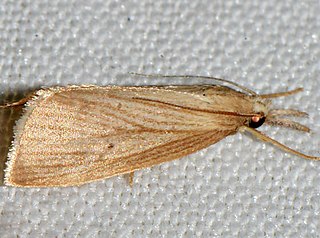
Diatraea evanescens is a moth in the family Crambidae. It was described by Harrison Gray Dyar Jr. in 1917. It is found in the US states of Alabama, Arkansas, Florida, Georgia, Louisiana, Maryland, Mississippi, North Carolina, Ohio, Oklahoma, South Carolina, Tennessee and Texas.
Neodactria murellus is a moth in the family Crambidae. It was described by Harrison Gray Dyar Jr. in 1904. It is found in North America, where it has been recorded from Arkansas, British Columbia, Colorado, Illinois, Indiana, Manitoba, Michigan, New Jersey, Ohio, Oklahoma and Washington. The habitat consists of tallgrass prairies.
Donacaula nitidellus is a moth in the family Crambidae. It was described by Harrison Gray Dyar Jr. in 1917. It is found in North America, where it has been recorded from Alberta, Alabama, Connecticut, Georgia, Maryland, Massachusetts, Mississippi, New Jersey, New York, North Carolina, South Carolina and Texas.
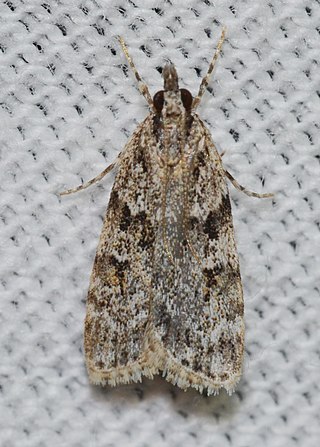
Scoparia biplagialis, the double-striped scoparia moth, is a moth in the family Crambidae. It was described by Francis Walker in 1866. It is found in North America, where it has been recorded from Alabama, Alaska, Alberta, British Columbia, California, Colorado, Florida, Georgia, Illinois, Indiana, Kentucky, Maine, Manitoba, Maryland, Massachusetts, Michigan, Minnesota, Montana, New Brunswick, New Hampshire, New Jersey, New York, North Carolina, North Dakota, Nova Scotia, Ohio, Ontario, Oregon, Pennsylvania, Quebec, Tennessee, Virginia, Washington, West Virginia and Wisconsin.
Scoparia cinereomedia is a moth in the family Crambidae. It was described by Harrison Gray Dyar Jr. in 1904. It is found in North America, where it has been recorded from British Columbia, Kentucky, Maine, Manitoba, Maryland, New Brunswick, New Hampshire, North Carolina, Nova Scotia, Ohio, Ontario, Quebec, South Carolina, Tennessee, Virginia and West Virginia.
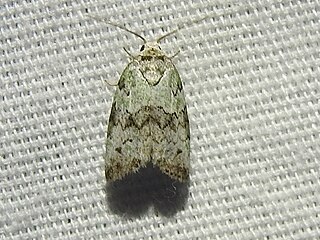
Afrida ydatodes, or Dyar's lichen moth, is a species of moth in the family Nolidae. It was described by Harrison Gray Dyar Jr. in 1913 and is found in North America, where it has been recorded from Alabama, Florida, Mississippi, North Carolina and Texas.
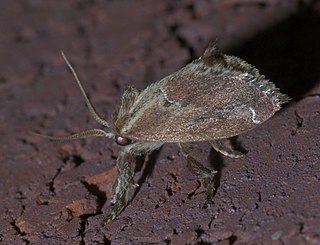
Adoneta is a genus of moths in the family Limacodidae. The genus was erected by James Brackenridge Clemens in 1860. There are at least four described species in Adoneta.
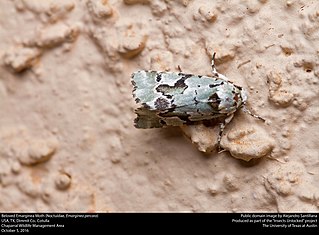
Psaphidini is a tribe of owlet moths in the family Noctuidae. There are at least 40 genera and at least 90 described species in Psaphidini.

Metalectra quadrisignata, the four-spotted fungus moth, is a species of moth in the family Erebidae. It is found in North America, where it has been recorded from Arizona, Florida, Georgia, Indiana, Iowa, Kentucky, Louisiana, Maine, Maryland, Massachusetts, Michigan, New Brunswick, New Hampshire, New Jersey, North Carolina, Ohio, Oklahoma, Pennsylvania, Quebec, South Carolina, Tennessee, Texas, Virginia, West Virginia and Wisconsin. The species was described by Francis Walker in 1858.
















